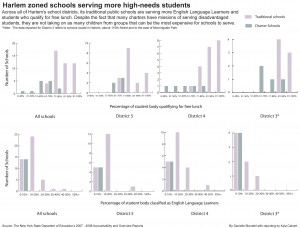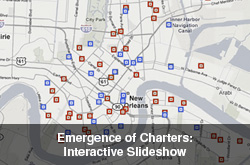Charters Leave Many High-Needs Public School Students Behind
Kyla Calvert | Jun 04, 2009 | Comments 13
BY KYLA CALVERT

A mural that greets students and visitors to P.S. 46. Photo: Kyla Calvert/COVERING EDUCATION
On a recent sunny afternoon, students ran and shrieked in the playground of Public School 46, tucked at the foot of the Polo Grounds Towers at Frederick Douglass Boulevard and 156th Street. A mural at the school’s front door shows a classroom of diverse children, raising their hands in eager anticipation. Bulletin boards in the hallways show off the students’ lively artwork.
In a neighborhood traditionally known for having some of the city’s most-troubled schools, P.S. 46 stands out as an oasis of stability. For much of Principal George Young’s 16-year tenure, his school has clocked in high achievement scores. Most recently it received a B on the school report cards. The results for the state’s English Language Arts tests released May 7 showed more than 65 percent of the tested students at P.S. 46 scored at grade level or higher. Still, in the last three years, the school’s enrollment has declined from 840 to 714 students.
“People aren’t having children as much as they were years ago,” Young offered as one explanation. But he is not convinced that childbirth rates alone account for the sudden dip. Some of these students, he believes, are drawn to the unusually large number of brand-new charter schools that have opened in Manhattan in recent years. Of the borough’s 26 total charter schools, 22 are located in Harlem; 16 opened in the last four years.
Schools like P.S. 46 find it impossible to compete. “Charters have a highly organized promotional process,” Young said. “They are flooding the community with literature, there are people going to the churches selling their schools.”
Along with the declining enrollment comes shrinking funds as well. As P.S. 46 has lost students over the last few years, it has also lost more than $200,000 from its budget.
And money is not the only thing that is leaving the school. Young and other principals believe that a disproportionate number of students who are not enrolling in the neighborhood’s charters are English-language learners and lower achievers.
Young has no argument with charter schools, as long as they provide viable options. “But they shouldn’t be sending the message that all public schools are bad,” he said. “I know public-school teachers who have gone out of their way to clothe and feed their students, to pay fees for college applications. These are the kinds of things people don’t know have been going on in public schools for years.”
At P.S. 76, on 121st Street, eight of the school’s 60 fourth-graders from last year transferred to charter schools for the fifth grade. All of the eight students performed at grade level or higher on the state’s standardized math and reading tests.
It is not clear if charter schools are specifically recruiting more academically accomplished students or not. What many administrators suspect is happening, however, is that the public schools are left with more students who have greater needs than before, said Marie Vallone, one of P.S. 76’s assistant principals.
The New York State Department of Education’s School Accountability and Overview Reports released in mid-April support their hunch. According to the demographic data from the 2007-2008 school year, Harlem’s charter schools are not serving students with the same level of need as the neighborhood’s zoned public schools. Two groups of students that often struggle to score highly on standardized tests — English language learners and those living in poverty — make up significantly smaller percentages of Harlem’s charter schools’ enrollment than they do at the area’s zoned schools.
The concentration of children in poverty remained higher in Harlem’s 45 traditionally-zoned schools compared to its charters. Last year, anywhere from 65 to 100 percent of students enrolled in Harlem’s zoned schools were eligible for free lunch, meaning their families qualified for public assistance.
By contrast, 10 of the 14 charters for which 2007-2008 data was available had fewer than 65 percent of their students qualifying.
Citywide, 78 percent of the students enrolled in charter schools for the 2007-2008 school year were eligible for free and reduced-price lunch, said Jeff Maclin, spokesperson for the New York City Charter School Center. Parents of students who are eligible for reduced-price lunch have slightly higher annual incomes than students who qualify for free lunch.
But no Harlem charter school had more than 71 percent of its students qualifying for free lunch, while 41 of the area’s 45 zoned schools had student bodies where 71 percent or more of the children were eligible.
The same trends were true when it came to English-language learners. Last year, in 10 of Harlem’s 14 charters, only one percent of children were learning English. None of the 14 schools enrolled more than 10 percent of that population.
In 35 of the neighborhood’s 45 traditional schools, between 6 and 20 percent of students needed special English training. At P.S. 155 in East Harlem, 48 percent of the students are English-language learners.
Citywide, less than 4 percent of charter school enrollees were English-language learners last year, said Maclin.
Department of Education officials said charter schools need to work on correcting this disparity between the percentage of students learning English in their schools and the public schools. Melody Meyer, deputy press secretary for the Department of Education, said the department now requires newly-authorized charters to provide a written plan for reaching out to the city’s non-English-speaking students, in order to increase their enrollment.
While disparities between citywide charter and traditional public school enrollment are not as great, charters are not distributed evenly across the city. They are concentrated in neighborhoods like Harlem and the South Bronx, where the city’s poorest families live. Staten Island, the wealthiest of the five boroughs, will see its first charter school open in the fall.
Some Harlem residents believe the recent proliferation of new charter schools in the neighborhood has exacerbated divisions between neighbors over whether charters or public schools provide better opportunities for their children.
Results on the state’s English Language Assessment showed a higher proportion of charter schools’ students scoring at grade level or higher than students in the city’s traditional public schools. Charters’ critics argue it is easier to push scores higher when the schools serve populations that are not the same as those being served in the city’s zoned schools.
“I think it is pretty clear, if you have a population that is already higher-achieving anyway that makes a big difference,” said Sam Coleman, a third-grade teacher at P.S. 24 in Sunset Park, Brooklyn, and a member of the New York Collective of Radical Educators. His organization has been part of a coalition of teachers’ groups organizing conferences and events to challenge school closings and the proliferation of charter schools across the city.
“You also have to look at how much time they spend doing test prep,” Coleman said. “You can get kids to get higher test scores without teaching them anything if you’re teaching them tricks. But, then you’re not teaching relevant content. I don’t think that charters having higher test scores means anything about the quality of education their kids are getting.”
Whether students attending charter schools really have access to better educational opportunities, the fact that there are not enough seats in these schools for the parents who want to enroll their children has led to emotionally-heated confrontations between charter and traditional public school parents in Harlem.
“We’re back to divide-and-conquer,” said Harriet Barnes, Harlem’s Community Education Council president, about the intense battles that raged this year over placing charter schools in public schools slated to be closed down.
“We have African-American parents in District 5 fighting against each other,” said Barnes, “so the Department of Education can do whatever it wants to do.”
Aside from causing divisions between residents, critics argue that charter schools run the risk of turning neighborhood public schools into places where high-needs students are isolated.
maintain a number of strong students,” he said. Between the 2005-2006 school year and last year, the percentage of students eligible for free lunch dropped slightly and the percentage of English-language learners was nearly unchanged.
However, P.S. 194 and P.S. 241, two schools that were recently removed from the list of schools slated to close, have seen more dramatic changes. According to the current information on the Department of Education’s Web site, English-language learners now make up more than 24 percent of P.S. 241’s student body, up from 17 percent in the 2005-2006 school year. Last year, 81 percent of the school’s students were eligible for free lunch, up from 72 percent the previous year.
At P.S. 194, 92 percent of the students were eligible for free lunch last year, up from 84 percent during the 2005-2006 school year. Currently, just over 12 percent of the students are learning English, compared to 7 percent during the 2005-2006 school year.
It is unclear what causes the differences in schools’ enrollment. “Traditional public schools may have stronger language programs in place, so charters feel no need to compete,” said Jeffrey Henig, professor of politics and education at Columbia University Teachers College. It is also possible that the area’s charter schools may not receive the federal funding for free-lunch programs for families on public assistance. Without the funding, charters would have no incentive to encourage parents to complete paperwork verifying their income levels.
Maclin pointed to a recent study of New York City charter school lotteries by Stanford economist Caroline Hoxby that concluded that the city’s charters are not “creaming” the most academically-able students from the public-school population. However, the pattern of Harlem charter schools enrolling fewer high-needs students than the surrounding public schools was dubbed “cropping off” by researchers. Henig found the same pattern in his study of charter schools in Washington, D.C.
“There was no evidence of charter schools creaming the most affluent kids from the public school system in D.C.,” said Henig. “But there was evidence of schools cropping off the highest-expense students. These are students who are going to tend to need more counseling, have problems with absenteeism and are going to be more likely to cause disruption to the classroom as a result. If schools are going to meet the needs of these students, they will either have to raise or divert funds to provide those services instead of directing that spending to the classroom.”
While some neighborhood schools achieve impressive results on standardized tests with high-risk student populations, doing so is not without its difficulties. Schools with high concentrations of children with multiple risk factors including poverty face numerous obstacles.
“In a public school that loses higher-achieving students and students who speak English as their native language, what ends up happening is that you end up with a classroom that is full of kids who are struggling in one way or another,” said Coleman. “It turns into a tracking system, where charter schools are just the higher track. It’s great for the charter schools’ students, their teachers and their parents. But it isn’t like they are creating smaller class sizes or hiring more teachers to support those struggling kids.”
Filed Under: New York City • Reshaping Communities
About the Author:















Charter schools are accountable to their sponsor usually a state or local school board to produce positive academic results and adhere to the charter contract. The basic concept of charter schools is that they exercise increased autonomy in return for this accountability. Charter schools are by definition independent public schools. Although funded with taxpayer dollars, they operate free from many of the laws and regulations that govern traditional public schools. Charter Schools are not forced to enroll students within a certain attendance zone. For example, Type 1 charter schools can accept students from anywhere in the district.
Nice site! I adore a few of the articles which have been written, and especially the comments posted! I am going to definately be visiting again!
i agree, in most cases, charter schools tend to siphon off well-to-do students and ditch those that won’t boost test scores
True enough. But my knowledge is too limited in
Free Personal Horoscope 2010 : http://astroloveh.co.cc
Thanks,
good information for me
My English is not good, not too much to see to understand. But thank you to share
True enough. But my knowledge is too limited inabercrombie london
True enough. But my knowledge is too limited in
hollister clothing
My English is not good, not too much to see to understand. But thank you to share..
hi i come again, thats very inspiring for me
It’s true, in most cases, charter schools tend to siphon off well-to-do students and ditch those that won’t boost test scores. As a result, the onus to educate special needs students falls on the public school systems, which are already over burdened as it is. A good overview of the topic.
I came across your blog today and am looking forward to reading the past posts!
This post resonated so loudly with me
hi there, nice info about school